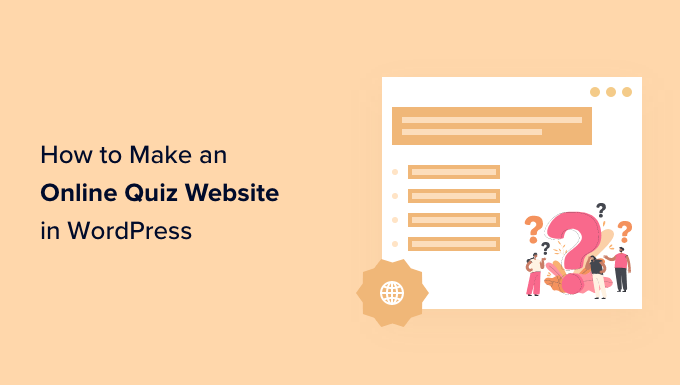How to Make an Online Quiz Website (Step by Step)

Introduction: Why Build an Online Quiz Website?
Creating an online quiz website can be a rewarding endeavor, whether for educational purposes, marketing lead generation, entertainment, or simply to test your coding skills. Quizzes are engaging, interactive, and offer immediate feedback, making them a powerful tool for learning and audience engagement. This guide will walk you through the steps required to build your own online quiz website, covering everything from initial planning to deployment.
Step 1: Planning and Defining Your Quiz Website
Before diving into code, careful planning is crucial. Define the purpose, target audience, and features of your quiz website. Consider the following:
- What is the main goal of the quiz website? (e.g., education, entertainment, lead generation)
- Who is your target audience? (e.g., students, professionals, general public)
- What types of quizzes will you offer? (e.g., personality quizzes, knowledge tests, surveys)
- What features will your website have? (e.g., user accounts, score tracking, leaderboards, social sharing)
- How will you monetize the website (if applicable)? (e.g., advertising, subscriptions, paid quizzes)
Answering these questions will help you make informed decisions about the technology stack, design, and content of your quiz website.
Step 2: Choosing Your Technology Stack
The technology stack you choose will heavily influence the development process. Here’s a breakdown of common options:
Frontend (What Users See)
- HTML, CSS, JavaScript: The fundamental building blocks of the web. HTML provides the structure, CSS the styling, and JavaScript the interactivity.
- JavaScript Frameworks (React, Angular, Vue.js): These frameworks offer pre-built components and tools to streamline development, especially for complex user interfaces. React is a popular choice for its component-based architecture and virtual DOM, leading to faster rendering. Angular is a comprehensive framework suited for large-scale applications, while Vue.js is known for its simplicity and ease of learning.
Backend (Server-Side Logic and Data Storage)
- Node.js with Express: A JavaScript runtime environment that allows you to run JavaScript on the server. Express is a popular Node.js framework that simplifies the creation of web applications and APIs.
- Python with Django or Flask: Python is a versatile language well-suited for web development. Django is a high-level framework that provides many features out-of-the-box, while Flask is a micro-framework that offers more flexibility and control.
- PHP with Laravel: PHP is a widely used server-side scripting language. Laravel is a modern PHP framework known for its elegant syntax and robust features.
- Databases (MySQL, PostgreSQL, MongoDB): Databases are used to store quiz questions, user information, scores, and other data. MySQL and PostgreSQL are relational databases that use structured data, while MongoDB is a NoSQL database that uses document-based data.
Hosting
- Shared Hosting: A budget-friendly option where your website shares resources with other websites on the same server.
- Virtual Private Server (VPS): Offers more control and resources than shared hosting, as you have a dedicated portion of a server.
- Cloud Hosting (AWS, Google Cloud, Azure): Provides scalable and flexible hosting solutions with pay-as-you-go pricing.
For a simple quiz website, HTML, CSS, and JavaScript with a static JSON file for quiz data might suffice. For more complex features like user accounts and score tracking, a backend framework like Node.js with Express and a database like MongoDB would be more appropriate.
Step 3: Setting Up Your Development Environment
Before writing any code, set up your development environment. This typically involves installing the necessary software and tools:
- Text Editor or Integrated Development Environment (IDE): Choose a code editor that suits your preferences. Popular options include VS Code, Sublime Text, Atom, and IntelliJ IDEA.
- Node.js and npm (Node Package Manager): If you’re using Node.js, install it from the official website. npm is included with Node.js and is used to manage project dependencies.
- Python and pip (Package Installer for Python): If you’re using Python, install it from the official website. pip is used to manage Python packages.
- Git: A version control system for tracking changes to your code. Create a repository on GitHub or GitLab to store your project.
- Database Management Tool: Install a tool to manage your database (e.g., MySQL Workbench, pgAdmin, MongoDB Compass).
Step 4: Designing the User Interface (UI)
The UI is how users interact with your quiz website. Keep it clean, intuitive, and visually appealing.
- Homepage: Provides an overview of the website and links to different quizzes.
- Quiz Selection Page: Displays a list of available quizzes with descriptions and previews.
- Quiz Page: Presents the quiz questions and answer options.
- Results Page: Shows the user’s score, feedback, and any relevant information.
- User Profile Page (Optional): Allows users to view their past scores and manage their account.
Use HTML for the structure, CSS for styling, and JavaScript for interactivity. Consider using a CSS framework like Bootstrap or Tailwind CSS to speed up the design process.
Step 5: Building the Frontend
The frontend is responsible for displaying the quizzes and handling user interactions. Here’s a general outline:
HTML Structure
Create the basic HTML structure for each page, including the header, navigation, main content, and footer. Use semantic HTML elements (e.g., `
